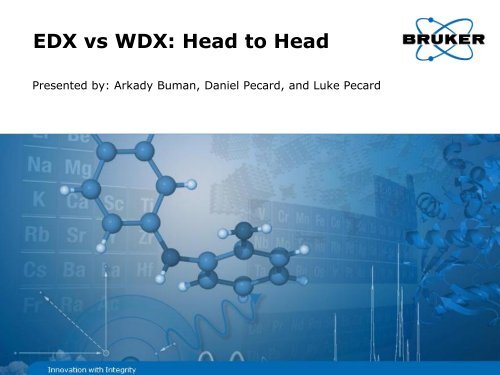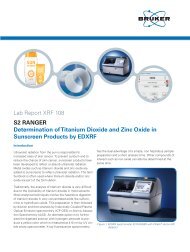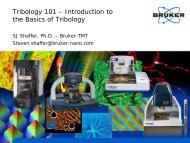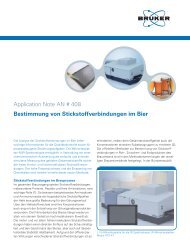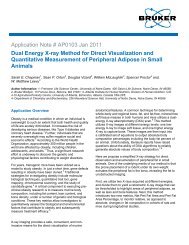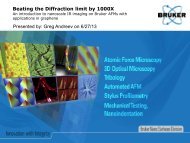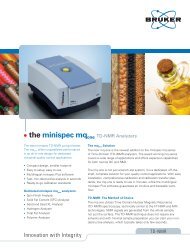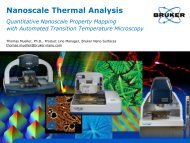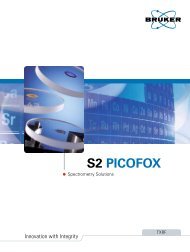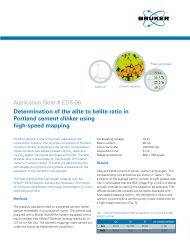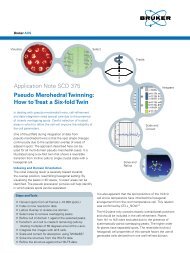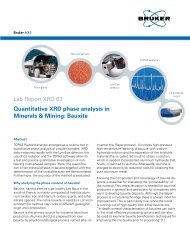EDX vs WDX - Bruker
EDX vs WDX - Bruker
EDX vs WDX - Bruker
Create successful ePaper yourself
Turn your PDF publications into a flip-book with our unique Google optimized e-Paper software.
<strong>EDX</strong> <strong>vs</strong> <strong>WDX</strong>: Head to Head<br />
Presented by: Arkady Buman, Daniel Pecard, and Luke Pecard<br />
April 18, 2012
Welcome<br />
Today’s Topics:<br />
Arkady Buman<br />
XRF Product Manager<br />
• How energy-dispersive<br />
(<strong>EDX</strong>) and wavelengthdispersive<br />
(<strong>WDX</strong>) X-ray<br />
spectrometry work<br />
• Capabilities and advantages<br />
of <strong>EDX</strong><br />
• Capabilities and advantages<br />
of <strong>WDX</strong><br />
• Audience poll – which<br />
technique wins for your<br />
applications?<br />
• New S8 DRAGON<br />
• Q & A<br />
Luke Pecard (<strong>EDX</strong>)<br />
XRF Applications<br />
Scientist<br />
Daniel Pecard (<strong>WDX</strong>)<br />
XRF Sr. Applications<br />
Scientist<br />
April 18, 2012 2
X-ray Fluorescence Analysis<br />
X-ray Spectrometry<br />
...is the method to do<br />
qualitative and quantitative analysis<br />
of elemental composition<br />
by excitation of atoms<br />
and detection of their<br />
characteristic X-rays<br />
April 18, 2012 3
X-ray Fluorescence Analysis<br />
X-ray Spectrometry<br />
...is the method to do qualitative and quantitative analysis of<br />
elemental composition<br />
by excitation of atoms and detection of their characteristic X-rays<br />
April 18, 2012 4
X-ray Fluorescence Analysis<br />
X-ray Spectrometry<br />
...is the method to do<br />
qualitative<br />
and<br />
quantitative<br />
analysis<br />
of elemental composition<br />
by excitation of atoms and<br />
detection of their<br />
characteristic X-rays<br />
• Qualitative analysis<br />
• identification of elements<br />
• "What‘s there?“<br />
• Quantitative analysis<br />
• determination of concentrations<br />
• “How much?“<br />
• Semi-quantitative analysis<br />
• estimation of concentrations<br />
• “About how much?“<br />
April 18, 2012 5
Sample Excitation by X-Ray Tube<br />
sample<br />
Each element present in<br />
the sample emits<br />
secondary fluorescence of<br />
a unique energy<br />
For <strong>WDX</strong><br />
• Soller slit<br />
• Analyzer crystal<br />
• Detector<br />
For <strong>EDX</strong><br />
• Detector only<br />
April 18, 2012 6
Wavelength-Dispersive X-ray (<strong>WDX</strong>)<br />
Spectrometry<br />
Sample<br />
• An analyzer crystal separates<br />
the various wavelengths. λ<br />
(energies, E)<br />
• The detector records only the<br />
number (N) of X-ray photons at<br />
a given wavelength (energy)<br />
April 18, 2012 7
Wavelength-Dispersive X-ray<br />
A Closer Look<br />
April 18, 2012 8
Wavelength-Dispersive XRF (<strong>WDX</strong>)<br />
Analyzer Crystal and Bragg´s Equation<br />
sin 2d n<br />
April 18, 2012 9
Wavelength-Dispersive XRF (<strong>WDX</strong>)<br />
Sequential Spectrometers<br />
Collimators<br />
Sample<br />
• Sample emits X-rays in all<br />
directions<br />
• Sequential spectrometers<br />
require (nearly) parallel beams<br />
Collimator<br />
• Collimator suppresses X-rays<br />
which are not close to parallel<br />
April 18, 2012 10
Benchtop Energy-Dispersive XRF (<strong>EDX</strong>)<br />
• The detector is used to record<br />
both:<br />
• Energy of X-ray photons<br />
• Number of X-ray photons at<br />
a given energy<br />
April 18, 2012 11
Benchtop Energy-Dispersive XRF (<strong>EDX</strong>)<br />
A Closer Look<br />
April 18, 2012 12
What elements can be measured?<br />
April 18, 2012 13
What elements can be measured?<br />
<strong>WDX</strong><br />
<strong>WDX</strong>: Boron – Uranium<br />
April 18, 2012 14
What elements can be measured?<br />
<strong>EDX</strong><br />
<strong>EDX</strong>: Sodium – Uranium<br />
with X-Flash LE: Fluorine – Uranium<br />
April 18, 2012 15
What are the requirements for<br />
sample size?<br />
April 18, 2012 16
Sample Size<br />
<strong>WDX</strong><br />
• Sample must fit into the sample cup<br />
• Standard Template<br />
• 60 available positions<br />
• Mask sizes: 5, 8, 23, 28, and 34 mm<br />
• Sample cannot be larger than 51.5 mm<br />
in diameter<br />
• Easy Loader Template<br />
• 75 available positions<br />
• Mask sizes: 5, 8, 23, 28, and 34 mm<br />
• Sample cannot be larger than 40 mm<br />
in diameter<br />
• Bare Sample Template<br />
• 108 available positions<br />
• 40 mm samples<br />
April 18, 2012 17
Sample Size<br />
<strong>EDX</strong><br />
• S2 RANGER manual unit:<br />
Single position<br />
• S2 RANGER automation unit:<br />
28 available positions<br />
• Ring Size<br />
• Aperture: 30 mm<br />
• Sample cannot be larger<br />
than 40 mm in diameter<br />
• Can run larger, irregular-shape<br />
samples<br />
• Handheld XRF<br />
• ARTAX µXRF<br />
April 18, 2012 18
What is the resolution of the<br />
technique?<br />
April 18, 2012 19
Resolution<br />
<strong>EDX</strong><br />
<strong>EDX</strong> resolution depends on detector<br />
capabilities<br />
• Typical <strong>EDX</strong> resolution:<br />
Resolution<br />
<strong>WDX</strong><br />
• <strong>WDX</strong> resolution is:<br />
• Dependent on the<br />
collimator and crystal<br />
selected<br />
• Not dependent on the<br />
detector like <strong>EDX</strong> is<br />
• Typical resolution is<br />
What options are available for<br />
dealing with overlapping elements?<br />
April 18, 2012 22
Overlaps<br />
<strong>WDX</strong><br />
• Better resolution means less<br />
spectral line overlap and more<br />
accurate calibration<br />
• If a spectral line cannot be<br />
resolved from the spectral line of<br />
interest, then:<br />
• Try an alternate crystal<br />
• Use a finer collimator<br />
• If the above does not resolve the<br />
overlapping lines, then:<br />
• Choose an alternative line<br />
(K, L, etc.)<br />
• Apply mathematical overlap<br />
correction; need sufficient<br />
number of calibration<br />
standards<br />
April 18, 2012 23
KCps<br />
0 10 20 30 40 50 60 70<br />
Crystal Comparison<br />
Si: PET <strong>vs</strong>. XSCEM <strong>vs</strong>. InSb<br />
AQ-9A 30 KV None InSb 0.46 degr.<br />
AQ-9A 30 KV None PET 0.46 degr.<br />
AQ-9A 30 KV None XS-CEM 0.46 degr.<br />
24<br />
1.79<br />
1.78<br />
1.77<br />
1.76<br />
1.75<br />
1.74<br />
1.73<br />
KeV<br />
1.72<br />
1.71<br />
1.7<br />
1.69<br />
1.68<br />
1.67<br />
1.66
Overlaps - <strong>WDX</strong><br />
Na Kα1 and Zn Lα1<br />
XS-55 Crystal<br />
with 0.23<br />
Collimator<br />
TlAP Crystal<br />
with 1.0<br />
Collimator<br />
TlAP Crystal<br />
with 0.46<br />
Collimator<br />
TlAP Crystal<br />
with 0.23<br />
Collimator<br />
April 18, 2012 25
Overlaps - <strong>WDX</strong><br />
Collimators<br />
• “Coarse“ collimator: 0.46°<br />
• High intensity<br />
• Overlaps may not be separated<br />
• “Fine“ collimator: 0.23°<br />
• Low intensity<br />
• Good resolution<br />
• Good separation of lines<br />
• “Very Fine“ collimator: 0.12°<br />
• Lower intensity<br />
• Better resolution<br />
• Better separation of lines<br />
0.46°<br />
0.23°<br />
0.12°<br />
LiF 200<br />
Mn Ka1.2<br />
Cr K<br />
April 18, 2012 26
Cps<br />
20 60 100 200 300 400 500 600 1000 2000 3000 4000 5000 6000 7000<br />
Mg KA1<br />
Al KA1<br />
Si KA1<br />
Ca KA1/Escape<br />
P KA1<br />
S KA1<br />
Pd LA1<br />
Pd LB1<br />
K KA1<br />
Ca KA1<br />
Ca KB1<br />
Ti KA1<br />
Ti KB1<br />
V KA1<br />
Cr KA1<br />
V KB1<br />
Mn KA1<br />
Cr KB1<br />
Fe KA1<br />
Mn KB1<br />
Fe KB1<br />
Ca KA1/Sum<br />
Ca KA1/Sum<br />
Cu KA1<br />
Overlaps<br />
<strong>EDX</strong><br />
• <strong>EDX</strong> will show all spectral lines<br />
of the elements from the<br />
measurement region defined<br />
• If a spectral line cannot be<br />
resolved from the spectral line<br />
of interest, then:<br />
• Choose an alternative line<br />
(K, L, etc.)<br />
• Apply mathematical<br />
overlap correction; need<br />
sufficient number of<br />
calibration standards<br />
0.7 0.8 0.9 1 2 3 4 5 6 7 8 9<br />
KeV<br />
April 18, 2012 27
Cps<br />
10 20 30 40 50 60 80 100 200 300 400 500 600 700 800 900 1000 1100 1200 1300<br />
Mn KA1<br />
Fe KA1<br />
Mn KB1<br />
Overlaps - <strong>EDX</strong><br />
Slag Interference Fe K & Mn K<br />
5.7 5.8 5.9 6 6.1 6.2 6.3 6.4 6.5 6.6 6.7<br />
KeV<br />
April 18, 2012 28
KCps<br />
0 10 20 30 40 50 60 70 80 90<br />
Mn KB1<br />
Fe KA1<br />
Fe KA2<br />
Overlaps - <strong>WDX</strong><br />
Slag Interference Fe K & Mn K<br />
55 56 57 58 59 60<br />
degr. 2theta LiF200<br />
April 18, 2012 29
What are the count rate limitations?<br />
What is the maximum count rate?<br />
April 18, 2012 30
Count Rate Limitations<br />
<strong>EDX</strong><br />
• Total Counts:<br />
• 100,000 – 120,000 cps<br />
• For entire spectrum that is being excited<br />
from measurement conditions selected<br />
April 18, 2012 31
Count Rate Limitations<br />
<strong>WDX</strong><br />
• Can achieve a lot higher<br />
count rates compared to<br />
<strong>EDX</strong><br />
• Flow Proportional<br />
Detector:<br />
1.5 million cps per<br />
analytical line<br />
• Scintillation<br />
Detector:<br />
2 million cps per<br />
analytical line<br />
April 18, 2012 32
What is the precision?<br />
April 18, 2012 33
Cement Precision Study<br />
<strong>WDX</strong><br />
<strong>WDX</strong> is the most precise analytical technique available<br />
One sample run 50 times: Total time per sample was 113 seconds<br />
Roughly 10 seconds per element<br />
April 18, 2012 34
Cement Short Term Precision Study<br />
<strong>EDX</strong><br />
One sample run 12 times: Total time per sample was 200 seconds<br />
April 18, 2012 35
What are the typical detection<br />
limits?<br />
April 18, 2012 36
Lower Limit of Detection (LLD)<br />
• LLD is dependent on<br />
sample matrix<br />
• Oil matrix<br />
• <strong>EDX</strong>: 3 – 15 ppm<br />
• <strong>WDX</strong>: 0.2 – 3 ppm<br />
• Metal sample<br />
• <strong>EDX</strong>: 10 - 25 ppm<br />
• <strong>WDX</strong>: 1 – 8 ppm<br />
April 18, 2012 37
Trace Elements in Geological Sample<br />
Lower Limit of Detection<br />
April 18, 2012 38
What is the capability for measuring<br />
light elements?<br />
April 18, 2012 39
Light Elements<br />
<strong>EDX</strong><br />
• New detector technology has now made it<br />
possible to see even lighter elements with<br />
<strong>EDX</strong><br />
• X-Flash LE can measure down to the<br />
element Fluorine<br />
• X-Flash LE provides:<br />
• More than 8 times the sensitivity for<br />
Na (compared to standard SDD)<br />
• More than 4 times the sensitivity for<br />
Mg (compared to standard SDD)<br />
April 18, 2012 40
Light Elements<br />
<strong>WDX</strong><br />
• Better light element<br />
analysis with<br />
<strong>WDX</strong> (B) compared to <strong>EDX</strong><br />
(F / Na)<br />
• New crystal design for<br />
analysis of super light<br />
elements (B, C, N, O)<br />
• LLD for C in low alloy<br />
steel is now around 70<br />
ppm<br />
• Assuming surface<br />
preparation is properly<br />
done<br />
XS-B crystal: Boron in glass<br />
April 18, 2012 41
How long does it take to run a<br />
sample?<br />
April 18, 2012 42
Analysis Time<br />
<strong>WDX</strong><br />
• Time to analyze a sample depends<br />
on the following:<br />
• Element(s) to be<br />
measured<br />
• Concentration of the<br />
element(s)<br />
• Required detection limit<br />
• Required precision<br />
• Sequential <strong>WDX</strong><br />
• Measure for each element<br />
• Time to measure peak<br />
• Additional time may be<br />
necessary to measure<br />
background<br />
• Multichannel <strong>WDX</strong><br />
• Fixed-element channels<br />
• Reduces measurement time<br />
drastically<br />
• But lose ability to measure<br />
background<br />
April 18, 2012 43
Analysis Time<br />
<strong>EDX</strong><br />
• Time to analyze a sample depends<br />
on:<br />
• Element(s) to be<br />
measured<br />
• Concentration of the<br />
element(s)<br />
• Required detection limit<br />
• Required precision<br />
• Measure by regions<br />
• Typical to measure with one or<br />
two measurement regions<br />
depending on the elements of<br />
interest<br />
• < Ca:<br />
20kV with no filter<br />
• > Ca:<br />
40kV with Al filter<br />
• Heavy elements:<br />
50kV with Cu filter<br />
• Typical measuring time for slag,<br />
cement, and steel samples is<br />
5 - 10 min per sample,<br />
depending on precision<br />
requirement<br />
April 18, 2012 44
What about protection of the<br />
instrument from sample spillage or<br />
breakage?<br />
April 18, 2012 45
Protection - <strong>WDX</strong><br />
Sample Care and Easy Loader<br />
• Sample Care (4x Protection)<br />
• Two contamination shields to protect<br />
tube window and goniometer (3)<br />
• Dust reservoir to collect sample<br />
particles and droplets (6)<br />
• DuraBeryllium shield for tube window<br />
protection (2)<br />
• Unique vacuum seal with hightransmission<br />
window for goniometer<br />
protection (5)<br />
• Easy Loader<br />
• Prevents liquid samples from running<br />
under vacuum mode<br />
April 18, 2012 46
Protection - <strong>EDX</strong><br />
Dust Reservoir<br />
• Dust reservoir to collect sample particles<br />
and droplets<br />
• Easy access to sample chamber<br />
April 18, 2012 47
Are there any ASTM, ISO, or DIN<br />
norms that suggest which technique<br />
to use in the analysis of cement and<br />
petrochemicals?<br />
April 18, 2012 48
ASTM, ISO, and DIN Norms<br />
<strong>WDX</strong><br />
• Cement<br />
• ASTM C114 – Chemical Analysis of Hydraulic Cement (does<br />
not specify either <strong>EDX</strong> or <strong>WDX</strong>, but typically it is done by<br />
<strong>WDX</strong>)<br />
• Petrochemicals<br />
• ASTM D2622 – S in Petroleum Products by <strong>WDX</strong><br />
• ASTM D4927 – Elemental Analysis of Lubricant and Additive<br />
Components (Ba, Ca, P, S, Zn) by <strong>WDX</strong><br />
• ASTM D5059 – Lead in Gasoline<br />
• ASTM D6334 – S in Gasoline by <strong>WDX</strong><br />
• ASTM D6376 – Determination of Trace Metal in Petroleum<br />
Coke by <strong>WDX</strong><br />
• ASTM D6443 – Determination of Ca, Cl, Cu, Mg, P, S, & Zn in<br />
Unused Lubricating Oils and Additives by <strong>WDX</strong><br />
April 18, 2012 49
ASTM, ISO, and DIN Norms<br />
<strong>WDX</strong><br />
• Petrochemicals (continued)<br />
• ISO 14596 – Determination of S Content<br />
• ISO 14597 – Determination of V & Ni Content<br />
• ISO 15597 – Determination of Cl & Br Content<br />
• ISO 20884 – Determination of S Content of Automotive Fuels<br />
• DIN 13723 – Lead in Automotive Fuels<br />
• DIN 51363 – P in Lubricating Oils & Additives<br />
• DIN 51391 – Zn & Ca in Lubricating Oils<br />
• DIN 51431 – Mg in Lubricating Oils<br />
April 18, 2012 50
ASTM, ISO, and DIN Norms<br />
<strong>EDX</strong><br />
• Petrochemicals<br />
• ASTM D4294 – S in Petroleum and Petroleum Products by<br />
<strong>EDX</strong><br />
• ASTM D5839 – Trace Element Analysis of Hazardous Waste<br />
Fuel by <strong>EDX</strong><br />
• ASTM D6445 – S in Gasoline by <strong>EDX</strong><br />
• ASTM D6481 – Determination of P, S, Ca, & Zn in<br />
Lubrication Oils by <strong>EDX</strong><br />
• ISO 8754 – Determination of Sulfur Content<br />
• ISO 20847 – Determination of Sulfur Content of Automotive<br />
Fuels<br />
April 18, 2012 51
What peripherals are required or<br />
optional for each technique?<br />
April 18, 2012 52
Peripherals<br />
<strong>WDX</strong><br />
• Location of instrument and peripherals<br />
• Computer with instrument software<br />
• P-10 for Flow Proportional Detector<br />
• Haskris for 3 or 4 kW instrument<br />
• Correct country-specific power<br />
• UPS/TVSS (optional)<br />
• Helium for liquid and loose powder<br />
samples<br />
April 18, 2012 53
Peripherals<br />
<strong>EDX</strong><br />
• Location of instrument and peripherals<br />
• All-in-one design<br />
• Can be used as standalone unit<br />
(computer not required to run<br />
samples)<br />
• Correct country-specific power<br />
• Vacuum pump<br />
• Printer<br />
• UPS/TVSS (optional)<br />
• Helium for liquid and loose powder<br />
samples<br />
April 18, 2012 54
What is the cost difference between<br />
a benchtop <strong>EDX</strong> and a sequential<br />
<strong>WDX</strong>?<br />
April 18, 2012 55
Cost Difference<br />
• Typically, <strong>WDX</strong> is 2 -3 times more<br />
expensive than <strong>EDX</strong><br />
• <strong>EDX</strong> is more attractive because of<br />
price, but always remember to<br />
“Choose the Right Tool for the Job”<br />
April 18, 2012 56
Audience Poll<br />
Use your mouse to answer the<br />
question on your screen:<br />
Which technique is the winner for<br />
your applications?<br />
<strong>EDX</strong><br />
<strong>WDX</strong><br />
We will share the results with you<br />
before of the Q&A session.<br />
April 18, 2012 57
New truly simultaneous XRF<br />
S8 DRAGON<br />
• Truly simultaneous XRF spectrometer<br />
combining single element channels<br />
with the new Multielement Channel TM<br />
• Covers almost the whole periodic<br />
table from C upwards in one run in<br />
less than 40 seconds<br />
• 4 kW high excitation power<br />
• Unmatched precision for all relevant<br />
elements in metal production and<br />
foundries<br />
• Footprint more than 25% smaller<br />
than traditional instrument<br />
April 18, 2012<br />
58
S8 DRAGON<br />
Spectrometer Setup<br />
April 18, 2012<br />
59
S8 DRAGON<br />
Multielement Channel<br />
Essential benefits of the unique<br />
Multielement Channel TM<br />
• Elemental fingerprinting<br />
• Identification and analysis of all<br />
elements from Na upwards<br />
• Analytical flexibility<br />
• Contaminations can be traced<br />
• Analysis of non-routine samples<br />
• Upgrading of analytical methods<br />
with additional elements in<br />
minutes - no further installation<br />
of new hardware<br />
• Dual-mode data acquisition<br />
• Internal backup for data safety<br />
with a second internal source<br />
April 18, 2012<br />
60
Spectrum Iron Ore<br />
Dual Mode Data Acquisition<br />
Parallel measurement of SEC (<strong>WDX</strong>) and Multielement Channel<br />
Identification of trace elements, internal backup (second information source)<br />
April 18, 2012 61
Precision Test for Steel<br />
40 s measurement time - Dual Mode<br />
Concentration<br />
RSD<br />
LLD<br />
Comment<br />
[%]<br />
[%]<br />
[PPM]<br />
Cu KA1 0 – 3.3 0.02 2<br />
Zn KA1 0 – 0.1 0.004 16<br />
Multielement<br />
Channel<br />
As KB1 0 – 0.1 0.002 6<br />
Zr KA1 0 – 0.1 0.007 10<br />
Nb KA1 0 – 1.1 0.01 75<br />
Multielement<br />
Channel<br />
Mo KA1 0 – 0.3 0.003 1 Two ranges<br />
0 – 3.2 0.013<br />
Sn KA1 0 – 0.2 0.002 4<br />
Ta LB1 0 – 0.3 0.008 12<br />
W LA1 0 – 11 0.06 6 Two ranges<br />
0 – 20 0.10<br />
Pb LA1 0 – 1.1 0.009 3<br />
April 18, 2012<br />
62
Concentration (%)<br />
Iron Concentration<br />
200 measurements: Fe 47.065 +/- 0.013<br />
Fe Repeatability<br />
47.4<br />
47.3<br />
47.2<br />
47.1<br />
47<br />
46.9<br />
46.8<br />
46.7<br />
46.6<br />
1 51 101 151<br />
Number of measurements<br />
April 18, 2012 63
Concentration (%)<br />
Iron Concentration<br />
200 measurements: P 0.031 +/- 0.001<br />
P Repeatability<br />
0.035<br />
0.033<br />
0.031<br />
0.029<br />
0.027<br />
0.025<br />
1 51 101 151<br />
Number of measurements<br />
April 18, 2012 64
Thank you for attending<br />
• Results of audience poll<br />
Which technique is the winner for<br />
your applications?<br />
<strong>EDX</strong><br />
<strong>WDX</strong><br />
• Q & A<br />
Please type any questions you may<br />
have for Luke (<strong>EDX</strong>) or Dan (<strong>WDX</strong>)<br />
in the Q&A panel on your right and<br />
then click Send.<br />
April 18, 2012 65
© Copyright <strong>Bruker</strong> Corporation. All rights reserved.<br />
www.bruker.com


